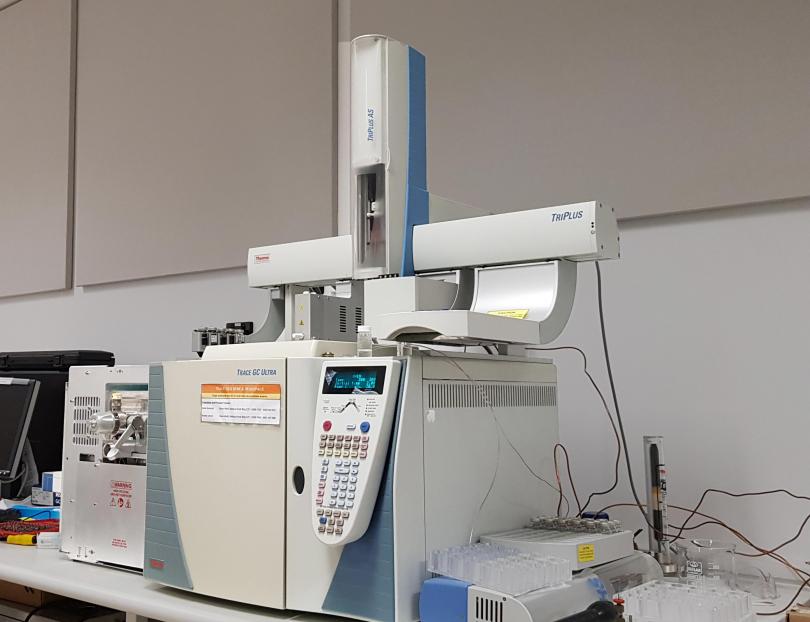
The Thermo DSQ II GC-MS instruments are suitable for analysis of compounds that are sufficiently volatile to enter the gas phase intact. The Mass Spectrometer of the Trace DSQ II GC-MS instrument at our Upper Campus facility can be operated in either electron impact (EI+) positive ionization mode, positive ion chemical ionization (CI+) mode, or electron capture negative ionization mode (ECNI or CI-). The Quadrupole MS gives nominal m/z assignments, accurate to +/- 0.2 Da. The associated gas chromatograph is equipped with both a split / splitless heated inlet and a programmable temperature vaporization (PTV) inlet. Samples in organic solution are normally injected using the Thermo Triplus Autoinjector. The Autoinjector can also be configured for gaseous / static headspace sampling or solid phase microextraction (SPME), facilitating automated analysis of the gaseous headspace volume above liquid samples. This is particularly useful for analyzing traces of volatile organic compounds in an aqueous matrix, e.g. coffee aroma, animal urinary scent signaling, chlorinated solvents contaminating drinking water.
Electron impact ionization (EI+) is the ‘standard’ ionization mode used with GC-MS and provides characteristic ion fragmentation mass spectra that can be compared with standard library reference spectra to identify unknown sample components. In some cases, involatile or thermolabile analytes can be chemically modified or derivatised to increase their volatility and/or thermal stability, thereby making them suitable for GC-MS analysis. Trimethylsilylation of –OH and –COOH is a frequently used approach. Chemical derivatization of samples prior to analysis can also be used to make analytes more electrophilic and amenable to negative ionization by electron capture (ECNI). This usually involves addition of perflourinated groups like pentafluorobenzyl- or hexafluoroisopropyl- to the analyte molecule. This approach can yield very high sensitivities with femtogram detection limits for some analytes and forms an excellent basis for trace quantitative analysis of target compounds.
Illustrative publications (2011-2018 with DOI Links) involving the Trace DSQ GC-MS at BMSF:
- Kumar, U., Gaikwad, V., Mayyas, M., Bucknall, M., & Sahajwalla, V. (2018). Application of High-Resolution NMR and GC-MS to Study Hydrocarbon Oils Derived from Noncatalytic Thermal Transformation of e-Waste Plastics. [https://doi.org/10.1021/acsomega.8b01284]. ACS Omega, 3(8), 9282-9289.
- Saha, B., Bucknall, M., Arcot, J., & Driscoll, R. (2018). Derivation of two layer drying model with shrinkage and analysis of volatile depletion during drying of banana. [https://doi.org/10.1016/j.jfoodeng.2018.01.010] Journal of Food Engineering, 226, 42-52.
- Saha, B., Bucknall, M. P., Arcot, J., & Driscoll, R. (2018). Profile changes in banana flavour volatiles during low temperature drying. [10.1016/j.foodres.2018.01.047] Food Res Int, 106, 992-998.
- Carthey, A. J. R., Bucknall, M. P., Wierucka, K., & Banks, P. B. (2017). Novel predators emit novel cues: a mechanism for prey naivety towards alien predators. [10.1038/s41598-017-16656-z] Sci Rep, 7(1), 16377.
- Das, B., Ezzedinloo, L., Bhadbhade, M., Bucknall, M. P., & Colbran, S. B. (2017). Strategic design of a ruthenium catalyst for both CO2 reduction and H2O oxidation: the electronic influence of the co-ligands. [10.1039/c7cc06294j] Chemical Communications, 53(72), 10006-10009.
- Mayyas, M., Pahlevani, F., Bucknall, M., Maroufi, S., You, Y., Liu, Z., & Sahajwalla, V. (2017). Thermocatalytic Conversion of Automotive Shredder Waste and Formation of Nanocarbons as a Process Byproduct. [https://doi.org/10.1021/acssuschemeng.7b00774] Acs Sustainable Chemistry & Engineering, 5(6), 5440-5448.
- Luu, W., Zerenturk, E. J., Kristiana, I., Bucknall, M. P., Sharpe, L. J., & Brown, A. J. (2014). Signaling regulates activity of DHCR24, the final enzyme in cholesterol synthesis. [Https://doi.org/10.1194/jlr.M043257] Journal of Lipid Research, 55(3), 410-420.
- McSkimming, A., Diachenko, V., London, R., Olrich, K., Onie, C. J., Bhadbhade, M. M., Bucknall, M. P., Read, R. W., & Colbran, S. B. (2014). An Easy One-Pot Synthesis of Diverse 2,5-Di(2-pyridyl)pyrroles: A Versatile Entry Point to Metal Complexes of Functionalised, Meridial and Tridentate 2,5-Di(2-pyridyl)pyrrolato Ligands. [https://doi.org/10.1002/chem.201402157] Chemistry-a European Journal, 20(36), 11445-11456.
- Risbud, M. R., Kononov, R., Bucknall, M., Welch, B. J., McCann, J. F., & Skyllas-Kazacos, M. (2012). Anodic and cathodic processes in piperidinium-based ionic liquid mixtures with AlCl3. [http://dx.doi.org/10.17628/ecb.2012.1.422-433] Eur. Chem. Bull., 1(10), 422-433.
- Khoury, R. R., Ebrahimi, D., Hejazi, L., Bucknall, M. P., Pickford, R., & Hibbert, D. B. (2011). Degradation of fatty acid methyl esters in biodiesels exposed to sunlight and seawater. [https://doi.org/10.1016/j.fuel.2011.03.041] Fuel, 90(8), 2677-2683.







